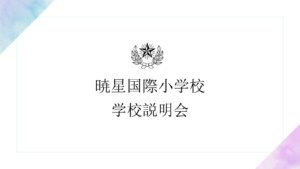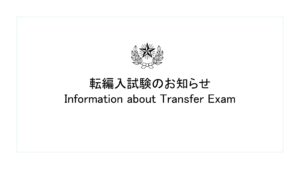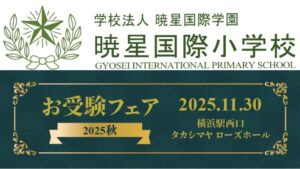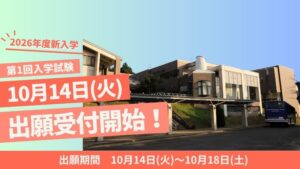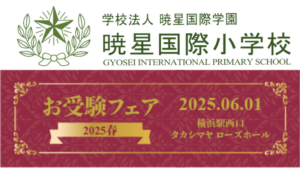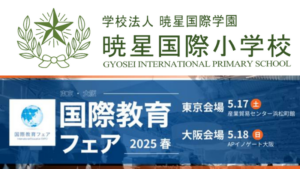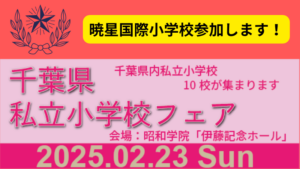How detailed does the medical check-up need to be?
If you visit your pediatrician and there are no problems please simply write “no problem” in the section for hearing and eyesight. Upon entering the school students will undergo a standard medical exam including EKG, hearing, and eyesight.
Is it possible to submit application forms directly to reception?
The reception desk for Gyosei Academy is located on the first floor of the administration building and application forms may be submitted directly there. Applications may be submitted from between October 26th and October 31st. Reception is open from 9:00 to 15:00 on weekdays and 9:00 to 12:00 on Saturday. The school is closed on Sunday. Applications submitted by post must reach the school within the submission period. Exam numbers will be issued according to the order in which application forms have been received. Application forms reaching the school prior to the 26th will be assigned test numbers after those who submitted the application form directly to reception. Entrance tests will be administered to consecutive groups with the last group scheduled to complete the test by 5:00 P.M.
How should applicants dress and what should they bring?
Girls should wear a pinafore dress or skirt with vest and boys should wear short pants and a shirt. They should be dark blue or gray. Applicants will take the sports test in the same clothes. Numbered jerseys will be supplied to the applicants on the day. Both applicants and parents should bring indoor shoes. No other items are required. Writing materials and other items necessary for the exam are provided by the school.
What is the purpose of the second entrance test?
Those with an interest in our school are strongly encouraged to take the first test. The second test is for those who express an interest in a course change or for applicants who for some reason were not able to perform to the best of their abilities the first time. We understand people make applications to multiple schools and the second test at our school is also available to assist in any possible conflicts that may occur with multiple applications.
What is the English conversational ability level for International Course applicants?
Almost all applicants to the International Course last year and the year before came from international preschools, had long experience living in English speaking countries or studied at English cram schools. Although a certain level of English fluency is required for admittance into the International Course, it is only one component on which applicants will be evaluated and a high level of proficiency is not necessarily a predictor of a high overall score. In order to maintain and foster the English environment of the international course it is helpful if students are able to easily communicate their own thoughts and feelings in English to peers and teachers to have an enjoyable start to the school year.
What is the language of communication among students during out of class time?
During the 20 minute morning and afternoon recess breaks all students play various games such as baseball, dodge ball, soccer, tag, and jump rope together. It is the school policy that during these times and while riding the busses, international course students communicate with each other using English. Regular course students and international course students communicate in either English or Japanese. When riding the bus, reading materials for International course students are expected to be in English.
Is there support for students who are unable to attend school for a number of consecutive days?
There are after school study sessions on Tuesday, Thursday, and Friday. If homeroom teachers or special course teachers feel there is a need for extra study sessions they will contact the students’ homes to request participation. Please note that participation is not mandatory. The after school play and study bus runs from the school to Kisarazu Station only. If participants live farther away they will need to make their own arrangements to return home from Kisarazu Station.
What does the entrance test entail?
On the paper test there are questions concerning numbers, logical reasoning, common knowledge, memory, and patterns. In the one to one interview, applicants are asked questions on par with the developmental level of a five-year-old. For applicants to the international course this part of the test is administered in English. The sports tests and the group behavior tests are conducted in groups of 10 students to evaluate applicants’ abilities to function harmoniously in groups. We also check that students have acquired the basic manners and living habits that would normally be taught at home.
<Questions regarding the school lunch;>
Where are the ingredients from and is there any danger from radiation?
Are provisions made for people with dietary needs?
What is the monthly fee?
The safety of our lunches is regulated by law and we take great care in following all requirements. Most of the ingredients come from Chiba prefecture. The water is supplied half by well water and half by the kisarazu water treatment utility. There is no danger of irradiated food products. We provide special lunches for students who have special dietary needs. The cost of the lunches is 10,000 yen a month.
How do the Japanese lessons taught for regular course compare to the Japanese lessons taught for the international course?
The regular course Japanese lessons and international course Japanese lessons are taught by the same grade level teacher. The same materials are used and the same information is taught at the same pace.
What is regular course English like?
Regular course English is taught by two teachers. Students are taught completely in English and begin by learning the alphabet in grade one. It is not uncommon for students to attain Eiken level two upon graduating. The same series of texts is used in both the international and regular course although the material is taken at a slower pace in the regular course.
What happens when a child becomes ill or requires medical attention while at school?
Students who become ill can rest in the nurse’s room under the school nurse’s care. If it is necessary for students to be picked up at school, the homeroom teacher will inform the household. In emergency cases where parents are unable to act, the child may be taken to hospital by ambulance or by school vehicle depending on the situation. In all cases we follow the school emergency guidelines.
If an applicant is unsuccessful on the first testing day is it possible to take the test again on the second testing day?
Yes. Please be aware that the test fee of 15,000 yen will apply.
Are there plans for bus service from Shinagawa?
Yes. From the 2012 school year there will be a line from Shinagawa.
How many teachers are there in the international division and what are their nationalities?
Refer to the English version of our website for this information.
Are there plans for a Junior high school bus service for Yokohama?
The matter is currently under review and is dependent on whether there is sufficient demand.
What sort of universities do international course students enter?
The first graduates of the international course are currently in their third year of Junior high School therefore no data is available at this time.
Regular course students who have entered the international course at Gyosei Junior and high School have gone on to Waseda, Sophia, ICU, Ritsumeikan, Hosei, and overseas universities. Apart from the big name universities students have gone into departments of medicine and dentistry at national universities.
How does the level of education compare with the national standard?
Gyosei students are ranked among the top 3% on national achievement tests. Regular course students complete the primary math curriculum by grade 5 and move onto more advanced material in their sixth year. Students in both the regular and international course learn Kanji at an advanced pace and begin using dictionaries from first grade.
What is the selection process and what is the ratio of applicants to successful candidates?
Although the judging system has not changed over the past 5 years, the average scores of the successful candidates have increased. All staff members are involved in the judging and selection process. Approximately half of all applicants are successful.
How is Christianity taught?
Religion is taught in place of the ministry of education required ethics course. Two Catholic Sisters provide instruction in Japanese for the regular course. Two international homeroom teachers provide instruction in English for the International course.
For enrolled students who go abroad and then return to Japan is it possible to reenter the school without retaking the entrance exam?
Depending on the number of students enrolled in the desired class there may be some difficulties in reentering a class. If there are no issues with capacity, students may reenter with an interview only. There is no need to take an entrance test or pay entrance fees.
What is the maximum number of students per class?
Variables such as students joining from abroad and students moving to other countries and back again make it difficult to establish an absolute maximum number. However, the school policy is to keep the number of students down to 30 whenever possible.
What are the monthly commutation fees?
Lines to and from Kisarazu Station: 5,000 yen
Lines other than those departing from Kisarazu station: 28,000 yen
What percent of students who graduate from the primary continue their education at Gyosei Junior High School?
About 60%of students continue. Busses from Urawa and Kawasaki are now in operation which makes it possible for students in these areas to continue on at the junior High.
To what extent is English supported in communication between school and home?
In the international division, class letters are written in English and home room teachers communicate with households in English. Additionally, the school news letter and some documents are available in English for any who make requests.
How many students have returned from abroad or are from abroad?
|
Grade |
1 |
2 |
3 |
4 |
5 |
6 |
Total |
|
Number |
3 |
11 |
2 |
14 |
7 |
8 |
45 |
The above figures are totals from both the regular and international courses.

